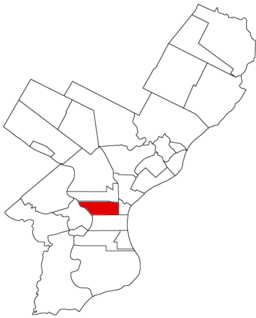Spring Garden District, Pennsylvania
| Spring Garden District | |
| Former District | |
| Country | United States |
|---|---|
| State | Pennsylvania |
| County | Philadelphia |
| Coordinates | 39°57′46″N 75°09′42″W / 39.96278°N 75.16167°WCoordinates: 39°57′46″N 75°09′42″W / 39.96278°N 75.16167°W |
| Timezone | EST (UTC-5) |
| - summer (DST) | EDT (UTC-4) |
| Area code | 215 |
 Map of Philadelphia County, Pennsylvania highlighting Spring Garden District prior to the Act of Consolidation, 1854 | |
|
Location of Spring Garden District in Pennsylvania | |
 Location of Pennsylvania in the United States | |
Spring Garden District is a defunct district that was located in Philadelphia County, Pennsylvania. The district ceased to exist and was incorporated into the City of Philadelphia following the passage of the Act of Consolidation, 1854. It corresponds largely (although not entirely) with today's Spring Garden neighborhood. At the time of its consolidation, it was one of the ten largest cities in the United States.
History
| Historical population | |||
|---|---|---|---|
| Census | Pop. | %± | |
| 1820 | 3,498 | — | |
| 1830 | 11,140 | 218.5% | |
| 1840 | 27,849 | 150.0% | |
| 1850 | 58,894 | 111.5% | |
Spring Garden appears in Varie’s map of 1796 as a small settlement between Vine Street and Buttonwood Lane and a point on a line with Seventh Street, and extending as far west as Ridge Road. There was a street (now known as Franklin Street) which ran north from Vine Street across Callowhill, and stopped opposite a house half-way between Callowhill, and Buttonwood Lane. The Street now known as Eighth Street (then called Garden Street) ran through the centre of the district, and the street now called Darien, formally Garden Street (then called Spring Street) ran from Vine to Buttonwood.
The district was incorporated March 22, 1813, as "the Commissioners and Inhabitants of the district of Spring Garden." The original boundaries were Vine Street on the south; the middle of Hickory Lane (afterwards Coates Street, now Fairmount Avenue) on the north; Broad Street on; the west, and the middle of Sixth Street on; the east.
On March 21, 1827, the district was enlarged by adding; that part of Penn Township beginning at the middle of Sixth Street to a point 210 feet north of the north side of Poplar Lane; thence northwest, parallel to the lane, at a distance of 200 feet from the latter, to the middle of Broad Street; thence parallel with Vine Street to the Schuylkill River.
The meaning of this was, that whilst the upper boundary of the district took a course from Sixth Street west by north to Broad Street, the line beyond the latter ran due east and west to the Schuylkill. It extended by the course of that river to Vine Street, and along the latter to Broad, where it met the old district line. By this addition the size of Spring Garden was more than doubled. At the time of consolidation the area of the district was estimated to be 1100 acres (4.5 km²).
The former diagonal street, York Avenue, a short section of which survives in Center City, formerly ran from Spring Garden to Fifth Street near Market Street and during the mid 19th Century served as a major commuter route for residents of the Spring Garden District who worked in what was then the central business district of Philadelphia.
Resources
- Chronology of the Political Subdivisions of the County of Philadelphia, 1683-1854
- Information courtesy of ushistory.org
- Incorporated District, Boroughs, and Townships in the County of Philadelphia, 1854 By Rudolph J. Walther - excerpted from the book at the ushistory.org website